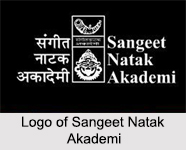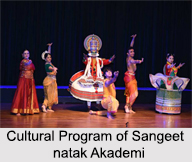 The Sangeet Natak Akademi was set up in 1953 for the encouragement of performing arts. A surrounding up of Sangeet Natak Akademi is one of the chief recommendations of the National conference on Dance, Drama, and Music, held in New Delhi in 1951. The Sangeet Natak Akademi is India's nationalized academy for music, dance and drama and is the first National Academy of the arts set-up by the Republic of India. The Akademi became well-designed the next year, with the meeting of its first Chairman, Dr P.V. Rajamannar, and the arrangement of its all-India committee of representatives, the General Council.
The Sangeet Natak Akademi was set up in 1953 for the encouragement of performing arts. A surrounding up of Sangeet Natak Akademi is one of the chief recommendations of the National conference on Dance, Drama, and Music, held in New Delhi in 1951. The Sangeet Natak Akademi is India's nationalized academy for music, dance and drama and is the first National Academy of the arts set-up by the Republic of India. The Akademi became well-designed the next year, with the meeting of its first Chairman, Dr P.V. Rajamannar, and the arrangement of its all-India committee of representatives, the General Council.History of Sangeet Natak Academy
The first President of India, Dr Rajendra Prasad, inaugurated it on 28th January 1953 in a special function held in the Parliament House. Maulana Abul Kalam Azad, who was then the Union Minister for Education at the inauguration of the Academy said -- "…It will be the aim of this Akademi to preserve our traditions by offering them an institutional form...”.
The Akademi's license of functions was prolonged along with the original lines in 1961, when the Sangeet Natak Akademi was reconstituted by the Government as a society and registered under the Societies Registration Act of 1860 (as amended in 1957).
Aims and Objectives of Sangeet Natak Academy
It acts as the national level for the following reasons:
Functions of Sangeet Natak Academy
The academy functions as the head body of the performing arts in the country to protect and endorse the huge cultural inheritance of India expressed in music, dance and drama. It also works with governments and art academies in states and territories of the country. SNA recognized quite a few institutions over the years and these are as follows:

Felicitations of Sangeet Natak Academy
SNA also offers felicitations or scholarships to deserving organisations in the same field.
Scholarship to Cultural Institutions
This scheme is proposed to allow the Sangeet Natak Akademi to tender grants-in-aid to select cultural institutions occupied in the endorsement of performing arts, namely, music, dance and drama. The grants-in-aid scheme is to hand out chiefly two objectives, explicitly, to offer financial support to institutions engaged in training in the fields of music, dance and drama and to encourage production of new plays and ballets, etc.
Schooling and Preservation
The Sangeet Natak Akademi extends support to identify forms of Indian music, dance and theatre and also crafts associated with performing arts, mainly through specialized training program under renowned masters.
For more, visit the link below:
https://www.indianetzone.com/4/sangeet_natak_academy.htm
https://www.indianetzone.com/4/sangeet_natak_academy.htm